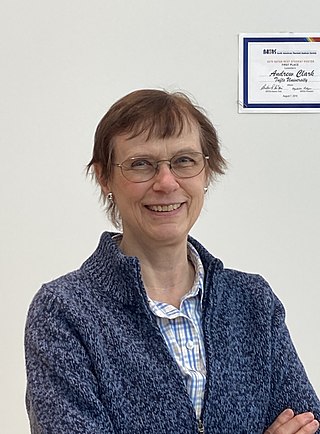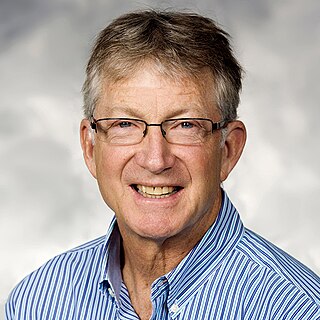Related Research Articles

Peter A. Freeman is the founding dean of Georgia Tech's College of Computing, a position he held from 1990 to 2002. Freeman was assistant director of the National Science Foundation from 2002 to 2007.
The Presidential Young Investigator Award(PYI) was awarded by the National Science Foundation of the United States Federal Government. The program operated from 1984 to 1991, and was replaced by the NSF Young Investigator (NYI) Awards and Presidential Faculty Fellows (PFF) program. In 1995, the NSF Young Investigator program was subsumed into the NSF CAREER Awards program, and in 1996, the Presidential Faculty Fellows program was replaced by the PECASE program.

Younan Xia is a Chinese-American chemist, materials scientist, and bioengineer. He is the Brock Family Chair and Georgia Research Alliance (GRA) Eminent Scholar in Nanomedicine in the Wallace H. Coulter Department of Biomedical Engineering, with joint appointments in the School of Chemistry & Biochemistry, the School of Chemical & Biomolecular Engineering, and Parker H. Petit Institute for Bioengineering & Bioscience at the Georgia Institute of Technology.
Michael J. Shelley is an American applied mathematician who works on the modeling and simulation of complex systems arising in physics and biology. This has included free-boundary problems in fluids and materials science, singularity formation in partial differential equations, modeling visual perception in the primary visual cortex, dynamics of complex and active fluids, cellular biophysics, and fluid-structure interaction problems such as the flapping of flags, stream-lining in nature, and flapping flight. He is also the co-founder and co-director of the Courant Institute's Applied Mathematics Lab.

Paula Therese Hammond is a David H. Koch Professor in Engineering and the Head of the Department of Chemical Engineering at the Massachusetts Institute of Technology (MIT). She was the first woman and person of color appointed as head of the Chemical Engineering department. Her laboratory designs polymers and nanoparticles for drug delivery and energy-related applications including batteries and fuel cells.
Radhika Nagpal is an Indian-American computer scientist and researcher in the fields of self-organising computer systems, biologically-inspired robotics, and biological multi-agent systems. She is the Augustine Professor in Engineering in the Departments of Mechanical and Aerospace Engineering and Computer Science at Princeton University. Formerly, she was the Fred Kavli Professor of Computer Science at Harvard University and the Harvard School of Engineering and Applied Sciences. In 2017, Nagpal co-founded a robotics company under the name of Root Robotics. This educational company works to create many different opportunities for those unable to code to learn how.
Nina Marković is a Croatian-American physicist. Her work focuses on quantum transport in low-dimensional systems, superconductivity, nanostructures, and quantum computing. She received a Sloan Research Fellowship in 2004. Marković worked at Delft University of Technology, Harvard University, and Johns Hopkins University before joining the Goucher College Department of Physics and Astronomy in 2015.
Autumn Kent is an American mathematician specializing in topology and geometry. She is a professor of mathematics and Vilas Associate at the University of Wisconsin. She is a transgender woman and a promoter of trans rights. In 2019, she received a Simons Fellowship.
Susan Margulies is an American engineer and assistant director of the U.S. National Science Foundation, heading the Directorate for Engineering. She is also the Georgia Research Alliance Eminent Scholar in Injury Biomechanics and Professor in the Wallace H. Coulter Department of Biomedical Engineering at the Georgia Institute of Technology and Emory University, where she served as chair from 2017 to 2021. She is a world leader in the biomechanics of head injury in infants.
Aissa Wade is a Professor of Mathematics at Pennsylvania State University. She was the President of the African Institute for Mathematical Sciences centre in Senegal.
Carina Curto is an American mathematician, a professor at Pennsylvania State University, and a Sloan Research Fellow. She is known for her work on mathematical neuroscience, including the applications of mathematics in both theoretical and computational neuroscience. Her recent work is funded by the BRAIN Initiative. She is an associate editor at SIAGA, a SIAM journal on applied algebra and geometry and on the editorial board at Physical Review Research.

Erika Tobiason Hamden is an American astrophysicist and assistant professor at the University of Arizona and Steward Observatory. Her research focuses on developing ultraviolet (UV) detector technology, ultraviolet–visible spectroscopy (UV/VIS) instrumentation and spectroscopy, and galaxy evolution. She served as the project scientist and project manager of a UV multi-object spectrograph, FIREBall-2, that is designed to observe the circumgalactic medium (CGM). She is a 2019 TED fellow.
Richard D. Robinson is an Associate Professor of Materials Science and Engineering at Cornell University.
Monika Schleier-Smith is an American experimental physicist studying many-body quantum physics by precisely assembling systems of ultracold atoms. These atomic, molecular, and optical physics (AMO) engineered systems have applications in quantum sensing, coherent control, and quantum computing. Schleier-Smith is an associate professor of physics at Stanford University, a Sloan Research Fellow, and a National Science Foundation CAREER Award recipient. Schleier-Smith also serves on the board of directors for the Hertz Foundation.

Peggy Cebe is a professor of physics in the Department of Physics and Astronomy of Tufts University.

James L. Skinner is an American theoretical chemist. He is the Joseph O. and Elizabeth S. Hirschfelder Professor Emeritus at the University Wisconsin-Madison. He is also a member of the Scientific Advisory Board of the Welch Foundation. Most recently, Skinner was the Crown Family Professor of Molecular Engineering, professor of chemistry, director of the Water Research Initiative and deputy dean for faculty affairs of the Pritzker School of Molecular Engineering at the University of Chicago. Skinner is recognized for his contributions to the fields of theoretical chemistry, nonequilibrium statistical mechanics, linear and nonlinear spectroscopy of liquids, amorphous and crystalline solids, surfaces, proteins, and supercritical fluids. Skinner is the co-author of over 230 peer-reviewed research articles.

Karan Jani is an Indian astrophysicist working on black holes, gravitational waves, and testing Albert Einstein's General Theory of Relativity. He is currently an assistant professor of physics and astronomy at Vanderbilt University, and holds the endowed position of Cornelius Vanderbilt Dean’s Faculty Fellow. He has worked at the LIGO Livingston Observatory in the US, the Albert Einstein Institute in Germany, the Georgia Institute of Technology, and the Perimeter Institute for Theoretical Physics in Canada. He is a member of the Indian Initiative in Gravitational-wave Observations effort to build a gravitational wave detector LIGO in India.
Jesse Thaler is an American particle physicist who is a professor at the MIT Department of Physics. He was named director of the NSF Institute for Artificial Intelligence and Fundamental Interactions (IAIFI) upon its creation in August 2020.
Zahra Sana Hazari is a physics education researcher, and a professor in the Department of Teaching and Learning and the STEM Transformation Institute at the Florida International University.
John Boyd Etnyre is an American mathematician at the Georgia Institute of Technology, and his research fields include contact geometry, symplectic geometry and low-dimensional topology. He earned his Ph.D. in 1996 from the University of Texas, Austin under the supervision of Robert Gompf. Etnyre was a postdoctoral scholar at Stanford University from 1997-2001. He was a faculty member at the University of Pennsylvania prior to joining the faculty at the Georgia Institute of Technology.
References
- 1 2 3 Siobhan Roberts (2019-05-17). "'Knitting Is Coding' and Yarn Is Programmable in This Physics Lab: For Elisabetta Matsumoto, knot theory is knit theory". The New York Times . Boston, MA. p. D1. Retrieved 2020-05-06.
For Dr. Matsumoto, knitting is more than a handicraft hobby with health benefits. She is embarking on a five-year project, 'What a Tangled Web We Weave,' funded by the National Science Foundation, to investigate the mathematics and mechanics of 'the ancient technology known as knitting.'
- ↑ Kat J. McAlpine (2016-01-25). "4D-printed structure changes shape when placed in water". Harvard Gazette . Retrieved 2020-05-06.
Reported today in Nature Materials, the 4D printing advance combined materials science and mathematics through the involvement of the study's co-lead authors: A. Sydney Gladman, a graduate research assistant advised by Lewis and specializing in the printing of polymers and composites at the Wyss Institute and SEAS, and Elisabetta Matsumoto, a postdoctoral fellow at the Wyss and SEAS advised by Mahadevan and specializing in condensed matter and material physics.
- ↑ "The science of knitting, unpicked". Phys.org . 2019-03-06. Retrieved 2020-05-06.
At the American Physical Society March Meeting in Boston this week, Matsumoto will present her work on the mathematical rules that underlie knitting.
- ↑ "Eleven Georgia Tech Faculty Members Receive NSF CAREER Awards". Georgia Tech Research Horizons . 2019-08-20. Retrieved 2020-05-06.
Eleven Georgia Tech faculty members have been chosen to receive National Science Foundation (NSF) CAREER awards in the latest round of funding provided to faculty members in the early stages of their research careers. CAREER awards are considered among the NSF's most prestigious honors.
- ↑ Mathemalchemy’s Team